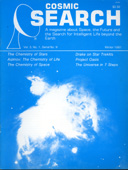![[NAAPO Logo]](../../Images/NAAPOsm.jpg) North American AstroPhysical Observatory (NAAPO)
|
|
The SEnTlnel
By: Robert S. Dixon
Project Oasis
In the summer of 1979, NASA gathered together some 25 scientists to seek a method of sifting through
all the data that will be produced by the super-powerful SETI receivers now being designed and tested by NASA. The study program was held at the NASA-Ames Research Center near San Francisco, California, and lasted for 10 weeks. Many different methods were investigated and reported on in detail, resulting in a mountain of paper. The editing process continued throughout 1979 and 1980, aided by a reunion of some of the same scientists in the summer of 1980 at NASA-Ames. Eventually, a
condensed final report will be published for distribution, either by NASA or by the University of Santa Clara, who co-hosted the study. In addition, we plan to have a full-scale article on Project Oasis in COSMIC SEARCH, but until then, this report will serve to summarize the basic findings.
NASA is currently designing SETI receivers that have 10 million separate narrow-band channels. Each of these channels provides amplitude and phase measurements from two independent antenna polarizations once per second, for a total data rate of 40 million measurements per second. This rate is so large that the scientists coined a new unit of measurement to deal with it — Encyclopedias Per Second. Most normal computers cannot even record data this fast, much less process it in the very complex ways required to search for intelligent signals that may lie hidden in the data.
The greatest difficulty confronting the Oasis scientists was that of not knowing exactly what to look for. If you know beforehand what kind of signal will be received, it is easy to construct a receiver that will be optimized for that particular kind of signal. Since no one can be sure what kind of signals might be received from other civilizations, the problem is very difficult. The problem is more philosophical than technological in some respects, analogous to trying to find a single wind-blown footprint in a large lumpy desert.
A common technique used by scientists to analyze their data is called a transform. This is a mathematical operation that rearranges the data in such a way that the desired part of the data (the signal) becomes clearly separated from the rest of the data (the noise). There are many different kinds of transforms, and each kind is best suited to a certain class of problems. For example, Fourier transforms are used to analyze problems that involve sinusoidal waves, and Walsh transforms are used to analyze problems that involve square waves. One of the goals of the Oasis scientists was to find what they dubbed a "cartoon" transform, that would distinguish between any signal and noise. This goal was not realized, although it suggests areas for future research.
Having been unsuccessful in finding a single, elegant, all-powerful method for analyzing the SETI data, the scientists instead designed a three-pronged approach to the problem. One prong is an optimized detector for that kind of signal that most believe is the likeliest — a narrow-band carrier. This detector not only uses the narrowbandedness of the signal, but its polarization and time coherent properties as well. In addition, it allows for a range of possible doppler frequency drift rates.
The second prong is optimized for signals that are in a sense opposite to those of the first prong. It searches for pulsed signals, over a wide range of pulse rates.
The third prong is conceptually the most complex. It is a "shotgun" approach, using a variety of techniques that are not specific to any particular signal. The received data is grouped into blocks representing 40 hertz of bandwidth and 20 seconds of time. Each block is then characterized by its response to a group of tests. The tests include ANOVA (an analysis of the statistical properties of the block), coherence, polarization, correlation and probability distribution measurements. After each block is so characterized, then a second stage processer searches for patterns of similar characterization among a large number of neighboring blocks. In this way, signals that are strange and exotic could be detected without knowing their characteristics beforehand.
Behind the scenes in all these methods is acutally a fourth prong — a human being. The scientists felt that the information processing power of the human brain is very significant, and should be given every opportunity to augment the automated tests performed by the computer. Therefore the Oasis receiver design incorporates means of displaying the received and processed data to a trained operator (via visual and audible displays). The operator is thereby able not only to monitor the proper operation of the automated equipment, but to actively participate in the search for intelligent signals.
The summer study program also produced some unanticipated side benefits, one of which is the "SETI Song," presented here. It was first sung at the final banquet of Project Oasis, and undoubtedly is destined to inspire all future SETI workers down through the ages.
By Norman Rhodine
(Sung to the tune of "Down by the Riverside")
They said the E.T.I.'s should be
The following are sung as the first and fifth lines of each of the remaining stanzas with "Down by the Water Hole" as the 2nd, 3rd, 4th, 6th and 7th lines in the same manner as for the first stanza:
So we searched to find our distant friends
|
